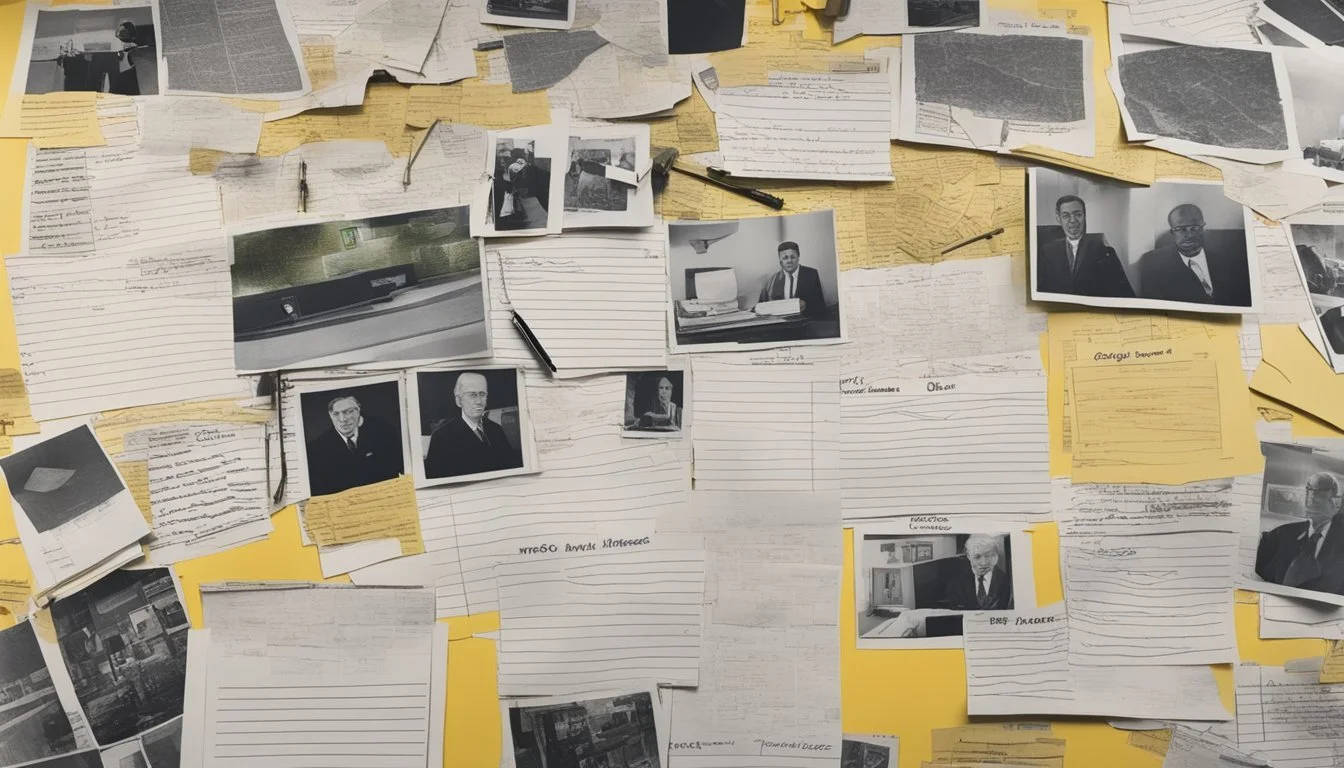Netflix Reopens JonBenét Case: Shocking New Evidence in Cold Case Documentary
The tragic murder of JonBenét Ramsey in 1996 continues to captivate public interest nearly three decades later. Netflix's new documentary series "Cold Case: Who Killed JonBenét Ramsey" revisits this haunting true crime mystery, offering fresh perspectives on the investigation. The three-part series features interviews with key figures, including JonBenét's father John Ramsey, and explores how police missteps and media sensationalism impacted the case.
This latest documentary joins a long line of productions examining the unsolved murder of the 6-year-old beauty pageant contestant. It aims to provide a comprehensive look at the decades-long search for justice, analyzing evidence and theories that have emerged over the years. The series also delves into the intense scrutiny faced by the Ramsey family and the lasting impact of the case on those involved.
As true crime content continues to surge in popularity, the JonBenét Ramsey case remains one of the most discussed and dissected mysteries in American history. This new documentary seeks to shed light on previously unexplored aspects of the investigation and challenge long-held assumptions about the crime.
The Life of JonBenét Ramsey
JonBenét Patricia Ramsey was born on August 6, 1990, in Atlanta, Georgia. She was the youngest child of John and Patsy Ramsey, joining her older brother Burke.
The Ramsey family moved to Boulder, Colorado, when JonBenét was young. There, she began participating in child beauty pageants, following in her mother's footsteps as a former beauty queen.
JonBenét quickly became known for her performances and wins in various pageants. She earned titles such as "Little Miss Colorado" and "National Tiny Miss Beauty."
Outside of pageants, JonBenét attended kindergarten at High Peaks Elementary School in Boulder. She was described as a friendly, outgoing child who enjoyed normal activities like riding her bike and playing with friends.
The Ramsey family lived in a large house in an affluent Boulder neighborhood. They were known for hosting elaborate Christmas parties each year.
Tragically, JonBenét's life was cut short at the age of 6. She was found murdered in the basement of her family's home on December 26, 1996, setting off one of the most high-profile unsolved cases in American history.
The case garnered intense media coverage and public interest. It sparked numerous documentaries, books, and television specials over the years, as the search for answers continues.
Overview of the Case
The JonBenét Ramsey case shocked the nation in December 1996. This high-profile murder investigation remains unsolved to this day, with numerous twists and turns captivating public attention for decades.
Murder and Initial Investigation
On December 26, 1996, six-year-old JonBenét Ramsey was found dead in the basement of her family's home in Boulder, Colorado. The child beauty queen had been strangled and suffered a skull fracture.
The Boulder Police Department quickly came under scrutiny for their handling of the crime scene. Critics argued that crucial evidence may have been contaminated or lost due to procedural errors.
Initially, suspicion fell on JonBenét's parents, John and Patsy Ramsey. However, they consistently maintained their innocence throughout the investigation.
Discovery of the Ransom Note
A bizarre element of the case was the discovery of a lengthy ransom note found inside the Ramsey home. The note demanded $118,000 for JonBenét's safe return.
Handwriting experts analyzed the note, but results were inconclusive. Some investigators believed the note was written by someone in the household.
The ransom demand raised questions about the true motive behind the crime. Was it a kidnapping gone wrong or staged to look like one?
Despite extensive forensic analysis and numerous theories, the JonBenét Ramsey murder remains one of America's most infamous unsolved cases.
Documentary Analysis
Documentaries about the JonBenét Ramsey case have played a crucial role in examining the evidence and keeping public interest alive. They present facts, employ various storytelling techniques, and contribute to ongoing discussions about true crime.
Presenting the Facts
Netflix's "Cold Case: Who Killed JonBenét Ramsey" reexamines the 1996 murder using modern technology. The docuseries highlights police missteps and media sensationalism that complicated the investigation. It presents key evidence, including the 911 call, ransom note, and DNA findings.
The series interviews experts and revisits crime scene details. It explores various theories about potential suspects, both within and outside the Ramsey family. By presenting this information, the documentary aims to provide viewers with a comprehensive overview of the case.
Documentary Style and Structure
True crime documentaries often use a mix of archival footage, reenactments, and expert interviews. "Who Killed JonBenét Ramsey" follows this format, weaving together past and present elements. The three-part structure allows for an in-depth exploration of different aspects of the case.
Visual aids such as timelines and evidence photographs help viewers understand complex information. The documentary's pacing builds tension and maintains viewer engagement. By presenting multiple perspectives, it encourages critical thinking about the evidence.
Role of Documentaries in True Crime
True crime documentaries serve several purposes in cases like JonBenét Ramsey's. They keep cold cases in the public eye, potentially generating new leads. These films can also expose flaws in investigations and legal proceedings.
Documentaries allow viewers to engage with cases as "armchair detectives." This involvement can spark renewed interest in unsolved crimes. However, filmmakers must balance entertainment value with ethical considerations regarding victims and their families.
Streaming platforms like Netflix have increased the reach of true crime documentaries. This wider audience can lead to greater public pressure for case resolution. Documentaries also often explore broader social issues related to crime and justice.
Media's Influence on the Case
The JonBenét Ramsey murder case quickly became a media sensation, drawing intense scrutiny from news outlets across the country. Cameras and reporters swarmed the Ramsey home and followed family members relentlessly.
This media circus created significant challenges for the Boulder Police investigating the crime. The constant presence of journalists and camera crews potentially compromised the integrity of the crime scene and evidence collection.
News coverage often focused on sensational aspects of the case, fueling public speculation about potential suspects. The Ramsey parents found themselves under a harsh spotlight, with many outlets implying their possible involvement.
The intense media attention may have influenced the direction of the police investigation. Pressure to solve the high-profile case quickly could have led to rushed judgments or overlooked leads.
Years later, documentaries like Netflix's "Cold Case: Who Killed JonBenét Ramsey" continue to examine how media coverage impacted the investigation. These retrospectives highlight potential missteps by both law enforcement and journalists in the crucial early stages of the case.
The enduring public fascination with the Ramsey murder demonstrates the lasting impact of the initial media frenzy. This ongoing interest continues to shape perceptions of the case nearly three decades later.
Law Enforcement and Investigative Efforts
The JonBenét Ramsey case has involved extensive police work, forensic analysis, and input from private investigators over the decades. Multiple agencies and individuals have contributed to the ongoing efforts to solve this high-profile murder.
The Boulder Police Department's Role
The Boulder Police Department took the lead in the initial investigation of JonBenét's murder. They faced criticism for their handling of the crime scene and early stages of the case.
Officers were accused of contaminating evidence and failing to properly secure the Ramsey home. This potentially compromised crucial forensic data.
The department has maintained active involvement in the case since 1996. They've reviewed evidence multiple times and followed up on thousands of tips from the public.
In recent years, the Boulder PD has partnered with other agencies to apply new technologies and investigative techniques to the case.
Detective Work and DNA Testing
Detectives have pursued numerous leads and theories over the years. They've interviewed hundreds of potential suspects and persons of interest.
DNA evidence has played a crucial role in the investigation. Male DNA was found on JonBenét's clothing that did not match any family members.
Advanced DNA testing methods have been applied to the evidence as technology improved. This includes the use of genetic genealogy databases to potentially identify relatives of the DNA contributor.
The Colorado Bureau of Investigation has assisted with forensic analysis and maintains an active role in processing evidence related to the case.
Contribution of Private Detectives
Several private investigators have worked on the Ramsey case, often hired by the family or media outlets. Lou Smit, a retired detective, was notable for his involvement.
Smit developed the "intruder theory" which contradicted the police's initial focus on the Ramsey family. He uncovered evidence that suggested an outsider may have committed the crime.
Private investigators have sometimes clashed with law enforcement over case theories and evidence interpretation. Their work has brought attention to overlooked aspects of the investigation.
Some have criticized the involvement of private detectives, arguing it complicates the official investigation. Others believe their contributions have been valuable in keeping the case active.
Impact on the Ramsey Family
The JonBenét Ramsey case had a profound effect on the Ramsey family. John and Patsy Ramsey faced intense public scrutiny and suspicion following their daughter's murder.
The couple endured years of media attention and accusations. They were subjected to frequent police interrogations and lived under a cloud of suspicion for over a decade.
Patsy Ramsey passed away in 2006 from ovarian cancer, never seeing her name cleared. John Ramsey continued to advocate for justice for JonBenét after his wife's death.
The case took a toll on the Ramseys' son Burke, who was only 9 years old at the time of the murder. He faced unfounded accusations and grew up in the shadow of his sister's unsolved case.
The Netflix documentary aims to exonerate the Ramsey family members. It presents evidence that casts doubt on their involvement and highlights the toll the investigation took on them.
John Ramsey has expressed hope that renewed interest in the case could lead to answers. He continues to seek justice for JonBenét and clear his family's name.
The documentary portrays the Ramseys as victims of a flawed investigation and media frenzy. It emphasizes the emotional and psychological impact of living under constant suspicion.
Critical Review of the Evidence
The JonBenét Ramsey case remains unsolved due to conflicting evidence and multiple theories. Key elements like the ransom note, DNA findings, and unidentified suspects continue to perplex investigators and the public.
The Ransom Note
The 2.5-page ransom note found in the Ramsey home raises many questions. Its unusual length and content have led to extensive analysis by experts. Some argue the note's handwriting matches Patsy Ramsey's, while others dispute this claim.
The note demanded $118,000, precisely matching John Ramsey's recent bonus. This detail fueled suspicions of an inside job. However, the note's language and pop culture references suggest it may have been written by an outsider familiar with crime movies.
Investigators have debated whether the note was written before or after the crime. The paper and pen used came from the Ramsey home, adding another layer of complexity to the evidence.
DNA Evidence
DNA evidence in the case has been both revealing and controversial. In 2008, touch DNA testing identified male DNA on JonBenét's clothing that did not match any Ramsey family members.
This finding led to the official exoneration of the Ramsey family. However, some experts argue that the DNA could have come from manufacturing or other contamination sources.
Recent advancements in DNA technology have renewed interest in the case. Investigators hope that more sophisticated testing methods might provide new leads or identify potential suspects.
The DNA evidence remains a critical yet contested aspect of the investigation, with ongoing debates about its significance and interpretation.
Unidentified Suspects
Several unidentified individuals have been linked to the case over the years. One key figure is the "Santa Claus" suspect, a man who played Santa at a Ramsey holiday party days before the murder.
Investigators also pursued leads related to a possible intruder. Reports of suspicious individuals in the neighborhood and an open basement window have fueled this theory.
The "foreign faction" mentioned in the ransom note led to speculation about possible international connections. However, no concrete evidence has emerged to support this idea.
Despite numerous tips and leads, law enforcement has been unable to conclusively identify or eliminate any specific suspects outside the Ramsey family.
Developments in Forensic Science
Recent advancements in forensic science have reignited interest in the JonBenét Ramsey case. DNA testing techniques have significantly improved since the initial investigation in 1996.
Investigators now have access to more sophisticated genetic analysis tools. These allow for the examination of smaller and more degraded DNA samples than was previously possible.
Touch DNA analysis has become a valuable method in cold cases. This technique can potentially identify DNA left behind from brief contact with evidence at the crime scene.
Genetic genealogy databases have emerged as a powerful resource for law enforcement. These databases can help identify potential suspects by linking crime scene DNA to relatives of the perpetrator.
Advanced imaging technologies now allow for enhanced examination of physical evidence. This includes improved analysis of fibers, fingerprints, and other trace materials found at the crime scene.
The Boulder Police Department has expressed commitment to utilizing these new forensic tools. They aim to re-examine existing evidence with cutting-edge techniques in hopes of uncovering new leads.
While no definitive breakthroughs have been announced, the application of these advanced methods offers renewed hope. Investigators continue to analyze evidence using the latest available technologies.
Public Perception and True Crime Fascination
The JonBenét Ramsey case has captivated the public for decades, becoming a prime example of true crime fascination. Its unsolved nature and sensational elements have fueled ongoing interest and speculation.
Media coverage of the case was intense from the start. News outlets competed for exclusive information, often prioritizing shocking headlines over factual reporting. This created a "media circus" atmosphere that complicated the investigation.
True crime documentaries and series have continued to revisit the case. Netflix's recent docuseries aims to reexamine the evidence and public perceptions. These productions often attract large audiences, demonstrating the enduring appeal of the mystery.
The case has sparked debates about wealth, privilege, and justice. Some critics argue that the family's social status influenced the investigation and media narrative. Others see it as an example of a flawed justice system unable to solve a high-profile crime.
Public opinion on the case remains divided. Online communities analyze evidence and propose theories. Social media has provided new platforms for discussing and debating the case details.
The ongoing fascination with the Ramsey case reflects broader trends in true crime entertainment. It raises questions about the ethics of turning tragedy into content and the impact on real-world investigations.
Prosecutorial Progress and Challenges
The JonBenét Ramsey case faced significant hurdles in the legal system. Prosecutors grappled with complex evidence and high public scrutiny as they sought justice for the young victim.
Alex Hunter's Prosecutorial Decisions
Alex Hunter, Boulder County District Attorney from 1973 to 2001, played a pivotal role in the case. He faced immense pressure to file charges but opted for a more cautious approach. Hunter convened a grand jury in 1998 to review evidence and hear testimony.
The grand jury voted to indict John and Patsy Ramsey on charges of child abuse resulting in death. However, Hunter declined to sign the indictment, citing insufficient evidence to secure a conviction.
This decision sparked controversy and debate among legal experts and the public. Some praised Hunter's restraint, while others criticized him for not pursuing charges more aggressively.
Evidence Standards and Legal Hurdles
The Ramsey case highlighted the challenges of prosecuting high-profile murders with circumstantial evidence. Investigators struggled to build a solid case that could withstand courtroom scrutiny.
Key issues included:
Contaminated crime scene
Lack of definitive DNA evidence
Conflicting expert opinions on ransom note
Prosecutors faced the daunting task of proving guilt beyond a reasonable doubt. The legal standard required strong, unambiguous evidence linking a suspect to the crime.
The case also raised questions about the influence of wealth and media attention on the justice system. Critics argued that the Ramseys' resources and public relations efforts impacted the investigation and prosecution decisions.
The Role of Streaming Services in True Crime
Streaming platforms have revolutionized access to true crime content. Netflix, in particular, has become a major player in this genre.
The platform's documentary "Cold Case: Who Killed JonBenét Ramsey" exemplifies this trend. It offers viewers an in-depth look at the infamous unsolved case.
Streaming services provide a wide audience for complex criminal investigations. They allow for longer, more detailed explorations of cases than traditional television.
These platforms can dedicate multiple episodes to a single case. This format permits thorough examination of evidence and theories.
True crime documentaries on streaming services often feature exclusive interviews. They may include family members, investigators, and experts involved in the case.
Netflix and other streaming giants have the resources to produce high-quality content. This includes reconstructions, archive footage, and advanced graphics to illustrate case details.
The on-demand nature of streaming allows viewers to engage with true crime at their own pace. They can pause, rewind, and rewatch to better understand complex cases.
Streaming services also enable the release of updated information. As investigations progress, new episodes or series can be added to existing documentaries.
The popularity of true crime on these platforms has led to increased public interest in cold cases. This attention sometimes prompts renewed investigations or generates new leads.
Cultural Impact and Legacy
The JonBenét Ramsey case has left an indelible mark on American culture since 1996. Its sensational nature captivated the public and media, sparking widespread interest in true crime stories.
The case highlighted issues surrounding child beauty pageants and their potential effects on young participants. It raised questions about the sexualization of children in these events and prompted debates on child safety.
Media coverage of the Ramsey case was extensive and often criticized as excessive. The intense scrutiny placed on the family and investigation set a precedent for how high-profile crimes are reported.
The unsolved nature of JonBenét's murder has kept it in the public consciousness for decades. Numerous books, documentaries, and TV specials have continued to examine the case, including recent Netflix productions.
Online communities dedicated to discussing and analyzing the case have flourished. Amateur sleuths and true crime enthusiasts regularly share theories and debate evidence.
The Ramsey case has influenced popular culture, inspiring fictional stories and being referenced in TV shows, movies, and music. It remains a touchstone for discussions about unsolved crimes and media sensationalism.
Law enforcement practices have been impacted by lessons learned from the investigation's perceived failures. The case has become a cautionary tale about preserving crime scenes and managing high-profile investigations.
Case Reevaluation and Modern Techniques
Recent efforts to reexamine the JonBenét Ramsey case have employed cutting-edge investigative methods and fresh perspectives. Experts are utilizing advanced forensic technologies and cold case techniques to uncover new leads.
Insights from Liz Feldman's Investigation
Liz Feldman, a prominent investigator, has brought new insights to the JonBenét Ramsey case. Her approach focuses on reanalyzing existing evidence using modern forensic tools. Feldman's team has scrutinized DNA samples with enhanced genetic testing methods.
These techniques offer higher sensitivity and accuracy compared to those available in 1996. The team has also employed advanced digital imaging to reexamine crime scene photos, potentially revealing previously overlooked details.
Cold Case Reinvigoration
The JonBenét Ramsey case has seen renewed interest from cold case experts. They are applying state-of-the-art scientific methods to reevaluate physical evidence. This includes using touch DNA analysis on items from the crime scene.
Investigators are also leveraging artificial intelligence to process vast amounts of case data. This technology helps identify patterns and connections that human analysts might miss. Additionally, forensic genealogy techniques, similar to those used in other high-profile cold cases, are being explored to potentially identify suspects through familial DNA matches.
Concluding Thoughts
The JonBenét Ramsey case continues to captivate public interest nearly three decades later. Recent documentaries have shed new light on this unsolved mystery, challenging long-held assumptions and theories.
These films have brought fresh perspectives to the investigation, presenting previously overlooked evidence and expert analyses. They have also given voice to key figures involved in the case, including JonBenét's family members.
The documentaries have highlighted significant investigative missteps and media sensationalism that may have hindered the pursuit of justice. They raise important questions about the initial handling of the crime scene and subsequent police work.
Advances in forensic technology offer hope for potential breakthroughs. DNA analysis and other modern investigative techniques could provide new leads or exonerate previously suspected individuals.
The renewed attention from these documentaries may encourage witnesses to come forward with new information. Public engagement could potentially generate fresh leads for investigators to pursue.
While the case remains unsolved, these documentaries serve an important role in keeping the investigation active. They remind us that behind the sensational headlines lies a tragic loss of a young life, deserving of continued efforts to uncover the truth.









